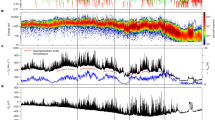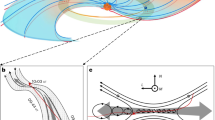Abstract
A transition between the supersonic solar wind and the subsonic heliosheath was observed by Voyager 1, but the expected termination shock was not seen owing to a gap in the telemetry1,2,3,4. Here we report observations of the magnetic field structure and dynamics of the termination shock, made by Voyager 2 on 31 August–1 September 2007 at a distance of 83.7 au from the Sun (1 au is the Earth–Sun distance). A single crossing of the shock was expected, with a boundary that was stable on a timescale of several days. But the data reveal a complex, rippled, quasi-perpendicular supercritical magnetohydrodynamic shock of moderate strength undergoing reformation on a scale of a few hours. The observed structure suggests the importance of ionized interstellar atoms (‘pickup protons’) at the shock.
This is a preview of subscription content, access via your institution
Access options
Subscribe to this journal
Receive 51 print issues and online access
$199.00 per year
only $3.90 per issue
Buy this article
- Purchase on Springer Link
- Instant access to full article PDF
Prices may be subject to local taxes which are calculated during checkout



Similar content being viewed by others
References
Burlaga, L. F. et al. Crossing the termination shock into the heliosheath: Magnetic fields. Science 309, 2027–2029 (2005)
Decker, R. B. et al. Voyager 1 in the foreshock, termination shock, and heliosheath. Science 309, 2020–2024 (2005)
Gurnett, D. A. & Kurth, W. S. Electron plasma oscillations upstream of the solar wind termination shock. Science 309, 2025–2027 (2005)
Stone, E. C. et al. Voyager 1 explores the termination shock region and the heliosheath beyond. Science 309, 2017–2020 (2005)
Winske, D. & Quest, K. B. Magnetic field and density fluctuations at perpendicular supercritical collisionless shocks. J. Geophys. Res. 93, 9681–9693 (1988)
Lembege, B. et al. Selected problems in collisionless shock physics. Space Sci. Rev. 110, 161–226 (2004)
Burgess, D. & Scholer, M. Shock front instability associated with reflected ions at the perpendicular shock. Phys. Plasmas 14, 012108 (2007)
Behannon, K. et al. Magnetic field experiment for Voyager-1 and Voyager-2. Space Sci. Rev. 21, 235–257 (1977)
Goodrich, C. C. in Collisionless Shocks in the Heliosphere: Reviews of Current Research (eds Tsurutani, B. T. & Stone, R. G.) 153–168 (Geophys. Monogr. Ser. Vol. 35, American Geophysical Union, Washington DC, 1985)
Scholer, M., Shinohara, M. I. & Matsukiyo, S. Quasi-perpendicular shocks: Length scale of the cross-shock potential, shock reformation, and implications for shock surfing. J. Geophys. Res. 108 (A1). 10.1029/2002JA009515 (2003)
Richardson, J. D., Kasper, J. C., Wang, C., Belcher, J. W. & Lazarus, A. J. Cool heliosheath plasma and deceleration of the upstream solar wind at the termination shock. Nature 10.1038/nature07024 (this issue)
Biskamp, D. & Welter, H. Numerical studies of magnetosonic collisionless shock waves. Nucl. Fusion 12, 663–666 (1972)
Phillips, P. E. & Robson, A. E. Influence of reflected ions on the magnetic structure of a collisionless shock. Phys. Rev. Lett. 29, 154–157 (1972)
Leroy, M. Structure of perpendicular shocks in collisionless plasmas. Phys. Fluids 26, 2742–2753 (1983)
Woods, L. C. On the structure of collisionless magneto plasma shock waves at supercritical Alfvén Mach numbers. J. Plasma Phys. 3, 435–442 (1969)
Gurnett, D. A. & Kurth, W. S. Intense plasma waves at and near the solar wind termination shock. Nature 10.1038/nature07023 (this issue)
Livesey, W. A. et al. ISEE 1 and 2 observations of magnetic field overshoots in quasi-perpendicular bow shocks. Geophys. Res. Lett. 9, 1037–1040 (1982)
Decker, R. B. et al. Mediation of the solar wind termination shock by non-thermal ions. Nature 10.1038/nature07030 (this issue)
Whang, Y. C., Burlaga, L. F. & Ness, N. F. Locations of the termination shock and heliopause. J. Geophys. Res. 100, 17015–17023 (1995)
Zank, G. P. et al. Interstellar pickup ions and quasi-perpendicular shocks: Implications for the termination shock and interplanetary shocks. J. Geophys. Res. 101, 457–477 (1996)
Lipatov, A. S. & Zank, G. P. Pickup ion acceleration at low β perpendicular shocks. Phys. Rev. Lett. 82, 3609–3612 (1999)
Newbury, J. A., Russell, C. T. & Gedalin, M. The ramp widths of high-Mach-number quasi-perpendicular collisionless shocks. J. Geophys. Res. 103 (A12). 29581–29593 (1998)
Lowe, R. E. & Burgess, D. The properties of rippling in quasi-perpendicular collisionless shock fronts. Ann. Geophys. 21, 1–9 (2003)
Lembege, B. & Dawson, J. M. Self consistent study of a perpendicular collisionless and nonresistive shock. Phys. Fluids 30, 1767–1788 (1987)
Lembege, B. & Savoini, P. Non-stationarity of a 2-D quasi-perpendicular supercritical collisionless shock by self-reformation. Phys. Fluids 4, 3533–3548 (1992)
Bale, S. D. & Mozer, F. S. Measurement of large parallel and perpendicular electric fields on electron spatial scales in the terrestrial bow shock. Phys. Rev. Lett. 98, 205001 (2007)
Acknowledgements
We thank T. McClanahan and S. Kramer for support in the processing of the data. We also thank D. Berdischevsky for computing the instrument zero level corrections for the data in this paper, and for helping to solve the problems created by the erroneous decoding of a spacecraft systems command sent to Voyager 2 in 2006. N.F.N. was partially supported by a NASA grant to CUA.
Author information
Authors and Affiliations
Corresponding author
Rights and permissions
About this article
Cite this article
Burlaga, L., Ness, N., Acuña, M. et al. Magnetic fields at the solar wind termination shock. Nature 454, 75–77 (2008). https://doi.org/10.1038/nature07029
Received:
Accepted:
Issue Date:
DOI: https://doi.org/10.1038/nature07029
This article is cited by
-
The Early History of Heliospheric Science and the Spacecraft That Made It Possible
Space Science Reviews (2022)
-
Observations of the Outer Heliosphere, Heliosheath, and Interstellar Medium
Space Science Reviews (2022)
-
Turbulence in the Outer Heliosphere
Space Science Reviews (2022)
-
Shocks in the Very Local Interstellar Medium
Space Science Reviews (2022)
-
Laboratory evidence for proton energization by collisionless shock surfing
Nature Physics (2021)
Comments
By submitting a comment you agree to abide by our Terms and Community Guidelines. If you find something abusive or that does not comply with our terms or guidelines please flag it as inappropriate.



